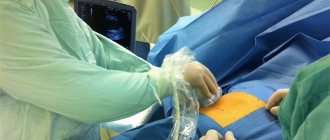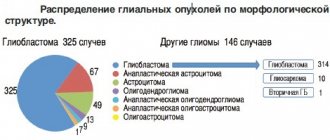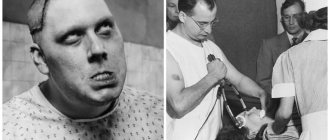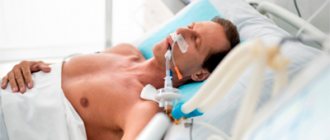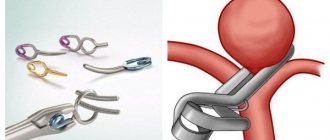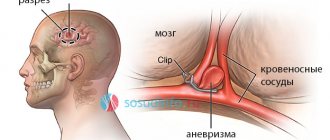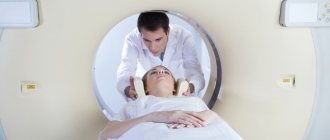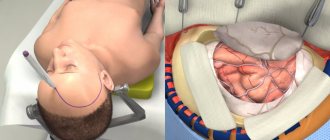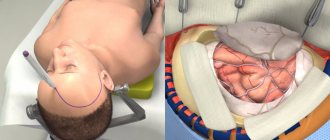Cardiovascular diseases are the leading cause of death among the population of most European countries. Most often, doctors are faced with arterial hypertension, which is a common cause of vascular accidents such as stroke or heart attack. But sometimes an increase in pressure leads to the rupture of a vessel aneurysm, if it exists in the brain. Rehabilitation after a brain aneurysm (more precisely, its rupture) consists of restoring the function of areas of the cortex and white matter affected by hypoxia.
- 6 Expected prognosis for cerebral aneurysm
- 7 Consequences after surgery for cerebral aneurysm: Video
Concept of cerebral aneurysm
An aneurysm is a change in the structure of the vessel wall, which results in the formation of a cavity inside the lining of the artery. It occurs against the background of a congenital defect of the vascular wall, endothelial infections, high blood pressure, and atherosclerotic process. The exact cause of the pathological condition is unknown.
There are several types of aneurysm. Among them are:
- saccular (at the site where the branch of the arteriole branches off from the main vessel, a bulge filled with blood appears);
- dissecting (for unknown reasons, the integrity of the vascular wall changes, resulting in the formation of a space between the endothelium and the muscle layer, where blood sweats).
In a physical sense, an aneurysm is a pathological increase in the diameter of a vessel, which leads to its rupture and further hemorrhage
Prognosis and prevention
Unfortunately, abdominal aortic aneurysm is one of the most insidious and unpredictable vascular pathologies, in which the probability of death exceeds 50%. Prevention and timely detection of an aneurysm are essential for a positive outcome. Quitting nicotine addiction, as well as monitoring blood pressure and taking timely measures to normalize it, helps reduce the risk of developing an aneurysm.
Technological progress is helping to reduce the number of diagnostic errors: modern research methods make it possible to identify pathology even in the absence of symptoms. Therefore, people who are at risk - smokers, hypertensive patients, elderly people, as well as those who have a high probability of developing a congenital pathology - should consult a doctor more often for a diagnostic examination. Often, patients are unaware of the development of an aneurysm until it ruptures, but then medical care may not be provided in a timely manner.
Be sure to consult a cardiac surgeon about being examined for the presence of an abdominal aortic aneurysm. Timely detection of the disease can save your life and in any case preserve your health and performance.
Recovery after surgery for a cerebral aneurysm
The only option to save the life of a patient with a brain aneurysm is immediate surgery. This involves clipping the affected vessel using a metal clip, which eliminates the damage.
Rehabilitation after surgery for a cerebral aneurysm requires a fairly long period. In the early stages, it involves the prevention of thrombotic complications and the fight against hypertension, as well as relieving the consequences of a hemorrhage that has occurred.
The early postoperative regimen involves keeping the patient in the intensive care unit and administering antibiotics to prevent infections.
Hemorrhagic stroke, which often accompanies an aneurysm, requires treatment according to all the rules of modern protocols, and the most severe complication of aneurysm rupture with the development of subarachnoid hemorrhage is cerebral vasospasm, which leads without treatment to the formation of secondary foci of ischemia.
Having moved to the general ward, the patient requires stable drug support in the form of cholesterol-lowering drugs and powerful antihypertensive therapy using central blocking drugs.
Recovery is noticeably accelerated with the inclusion of medications that improve cell metabolism and their energy efficiency.
Key points of rehabilitation after cerebral aneurysm
The patient can be discharged from the hospital only if there is confidence in the stability of blood flow in the affected segment of the vessel. Achievement of target blood pressure values and satisfactory results of cerebral angiography are also necessary. The absence of focal changes on the tomogram confirms the beginning of restoration of the damaged area of the brain parenchyma.
Further rehabilitation of the patient at home involves taking prescribed medications and following an individual program of exercises to restore functions controlled by the affected area of the brain. If this is part of the motor or sensory cortex, the patient is prescribed therapeutic exercises, massage procedures, and exercises on simulators.
If the functions of the limbic system, speech center, sensory organs, and the like are involved in the process, the patient needs classes with specialized rehabilitation therapists, a speech therapist, as well as verbal training methods.
Also, a patient who has suffered an aneurysm is recommended for annual planned hospitalization in a therapeutic hospital, a visit to a sanitary-resort institution that has a profile such as rehabilitation after removal of an aneurysm.
Every three months, such a patient, according to the protocol, must be examined by a neurologist, who is obliged to conduct basic screening tests (coagulogram, 24-hour blood pressure monitoring, general blood test).
What medications should a patient take after a cerebral aneurysm?
The patient’s medication plan depends on many factors: the presence of concomitant diseases, laboratory and instrumental indicators. Let's try to provide a drug treatment regimen for a typical representative of this group of patients.
The patient's first priority is to take statins (cholesterol-lowering drugs). It is also imperative to prescribe rational combination antihypertensive therapy, preferably using a diuretic.
One of the key medications will be a beta blocker, the selectivity of which must be chosen according to the situation. The purpose of this appointment is to reduce the force of heart contractions and slow down the pulse wave.
You can use metabolic support in the form of meldonium, arginine. Choline ascylate has proven itself well as a drug for restoring microcirculation of the brain parenchyma
Important elements of therapy are a disaggregant (clopidogrel) and a venotonic (detralex), thanks to which rehabilitation after a cerebral aneurysm will be free of high risks of endothelial complications.
Dietary patterns of patients who have had an aneurysm
Patients should avoid fatty foods, alcoholic beverages, and substances that can sharply increase blood pressure. It is worth paying attention to the consumption of unsaturated fats, which have a positive effect on cell metabolism. It is necessary to increase the intake of antioxidants in the form of fruits, vegetables, and juices.
There is evidence of the beneficial properties of dried fruits and nuts due to a large number of microelements that affect the functioning of the heart.
Rehabilitation after aortic aneurysm
Aortic aneurysm is a serious disease in which the integrity of the largest vessel in the body and, as a consequence, the entire blood circulation as a whole are disrupted. The pathology requires urgent cardiac surgery and modern treatment, such as installation of a stent and plastic surgery of the aortic wall. However, no less important is the subsequent rehabilitation of the patient with the restoration of full performance and preoperative quality of life.
Great successes in rehabilitation activities have been achieved by the First Medical Center of Tel Aviv, the largest clinic in Israel, where patients not only receive a recovery program after surgery, but also enjoy the unique Mediterranean climate. A positive aspect of treatment at the clinic is also the procedures at the Dead Sea, the healing waters of which help restore strength - https://telaviv-clinic.ru/clinic/disease/anevrizma-aorty/.
The operation of aortic plastic surgery and stent installation is quite traumatic, despite the fact that cardiac surgery in Israel is characterized by minimally invasiveness and endoscopic technologies. However, the vessel in which blood flows under enormous pressure is damaged. The surgical intervention lasts more than 8 hours, the patient is often connected to a heart-lung machine.
Therefore, even after successful treatment, the body needs a lot of time to recover. The patient should be monitored around the clock for at least the first 3-4 weeks. A Holter and heart rate monitor are installed, and the patient undergoes bicycle ergometry and duplex scanning of blood vessels every 6 hours. Cardiologists closely monitor how the aorta and heart work. In special cases, coronary angiography or MRI with contrast is performed.
Depending on the degree of the rupture and the extent of the surgical intervention, from 5 to 8 days, the patient is allowed minimal physical activity. From this time on, more and more new physical exercises are gradually introduced. All activity takes place under 100% control of specialists and according to a standard protocol.
After a month, you can gradually return to your pre-operative standard of living; medical supervision is no longer required. You only need to come once a week for a consultation and a superficial examination. During this period, various simulators are actively used, the heart learns to work in new conditions (with a stent).
While staying at the First Medical Center of Tel Aviv, in the final stages of rehabilitation, patients are actively involved in tourism and visit the holy places of Israel. And the unique minerals of the Dead and Mediterranean seas allow you to fully restore the body’s strength after treatment.
The material is posted as advertising
THERE ARE CONTRAINDICATIONS. SPECIALIST CONSULTATION IS REQUIRED.
What should such patients avoid?
Under no circumstances should you violate the established regime of mobility and physical activity. This can lead to a sharp increase in cardiac output and rupture of the clip (recurrent hemorrhage).
You should not stop taking prescribed medications without permission, as this can lead to complications in the postoperative period. Chronic lack of sleep, fatigue and nervous stress are contraindicated, which negatively affects the condition of the heart.
You should not skip scheduled visits to the doctor or refuse necessary diagnostic measures even after a successful operation.
Life after surgery
After open surgery, the body needs 2 to 4 months to fully recover and eliminate the consequences. When treating an arterial aneurysm endoscopically, the recovery time is significantly reduced. Recovery Features:
- for several days there is pain in the area of intervention, when the wound begins to heal, itching appears,
- in some cases, the consequence after removal of the aneurysm is swelling and numbness in the suture area,
- within 2 weeks it is considered normal for headaches, fatigue and anxiety to persist,
- up to 8 weeks, similar symptoms persist with open surgery,
- During the year, the patient should not engage in contact sports or lift weights exceeding 3 kg,
- You can’t sit for a long time.
After 6 weeks, the patient is allowed to start work if it does not involve physical activity.
As prescribed by the doctor, it is necessary to undergo MRI and CT, as they help monitor postoperative recovery.
After completion of the rehabilitation period, there remains a need for MRI every 5 years to exclude re-formation of the aneurysm. In general, reviews after surgery are positive. The most common side effects include deterioration of well-being due to sudden changes in weather.
Consequences of surgery for cerebral aneurysm
As a rule, successful surgery for an aneurysm leads to saving the patient's life. Of course, everything depends on related factors, such as the timeliness of assistance, the size of the aneurysm, the strength of the vascular wall, etc. Even in the case of successful surgery, it is often not possible to completely restore the function of the part of the brain affected by hemorrhage or compression to the patient.
In any case, since an aneurysm is, first of all, a physical deformation of a vessel, causing a change in the functioning of the adjacent section of the parenchyma, it is important for a patient with a morphologically confirmed diagnosis to undergo surgery in a timely manner.
Cost and direction
Patients with an aneurysm apply for free surgery, either endoscopically or by opening the skull. To do this, you need to contact regional or district clinics, which are then referred to larger medical centers.
Surgery to remove an aneurysm is also available for a fee. An open one costs 20-50 thousand rubles, and an endovascular one costs from 15 thousand. But in Moscow and some large cities
The price usually includes consumables and payment for the work of all medical staff. Separate payments may be required for medications and time spent in a private room.
In general, the prognosis after removal of an aneurysm is favorable: 80% of patients recover successfully and do not suffer from severe consequences . When bleeding occurs, the mortality rate can reach 50%.
Expected prognosis for cerebral aneurysm
With timely seeking medical help and successful coordinated actions of doctors, you can count on a good result. Of course, a prerequisite is to perform vessel clipping according to modern techniques and high-quality postoperative drug support. The type, size and location of the aneurysm also plays a role. If there is a large lesion in a hard-to-reach area, the prognosis is significantly worse.
It is worth paying attention to the improvement in prognosis for patients who do not suffer from concomitant diseases, such as diabetes mellitus or chronic heart failure.
Indications and contraindications
Medical removal of a cerebral aneurysm is possible only in a few cases. Indications for the most common type of surgery – clipping: aneurysm larger than 7 mm, predisposition to rupture of the swollen sac.
Before surgery, you must ensure that there are no contraindications. Surgeries cannot be performed if there are blood diseases . Interventions are prohibited in case of decompensation of diabetes, as well as in acute inflammation or infection of various etiologies.
Clipping of cerebral arteries is prohibited if the pathology is deep.
Intervention is not allowed in cases of exacerbation of chronic diseases, as well as in severe cases of bronchial asthma.
Prognosis after treatment method
After successful treatment such as resection of a carotid aneurysm, the following improvements are predicted:
In case of surgery on the right carotid artery, the general cerebral signs of an aneurysm disappear: headache, dyspepsia, impaired consciousness, psychomotor agitation, dizziness, fainting, convulsions in healthy limbs.
In case of surgery on the left carotid artery, motor aphasia, paresthesia, hemianopia, and epileptiform seizures disappear.
